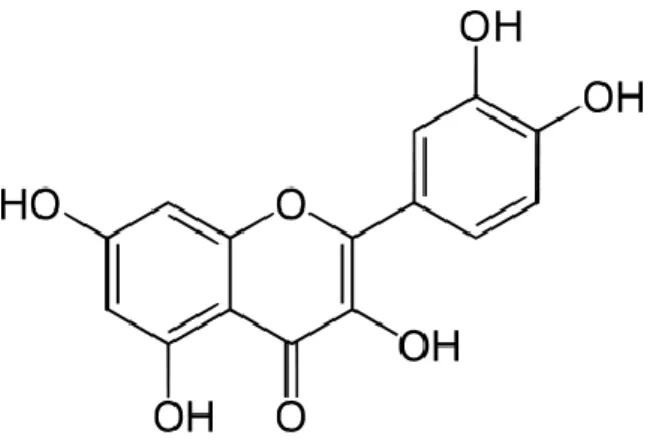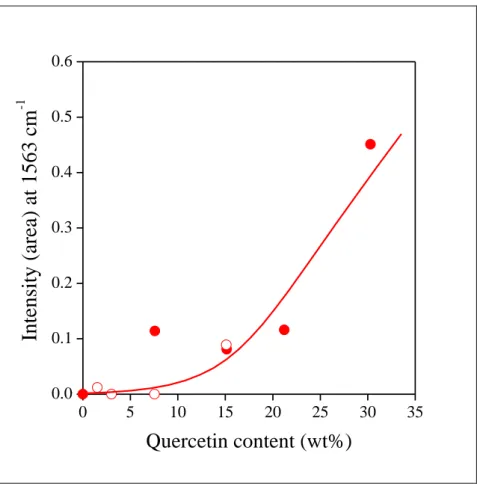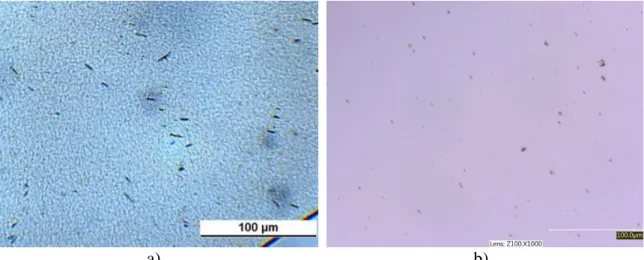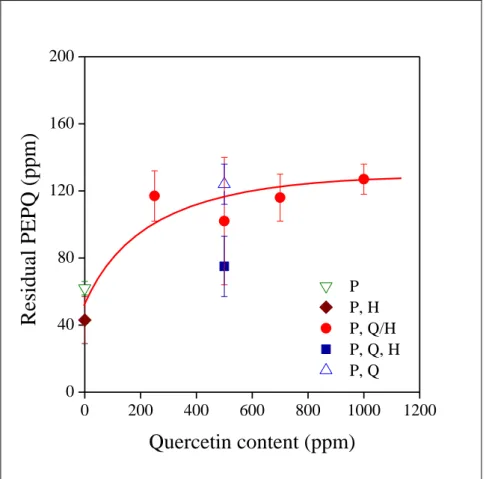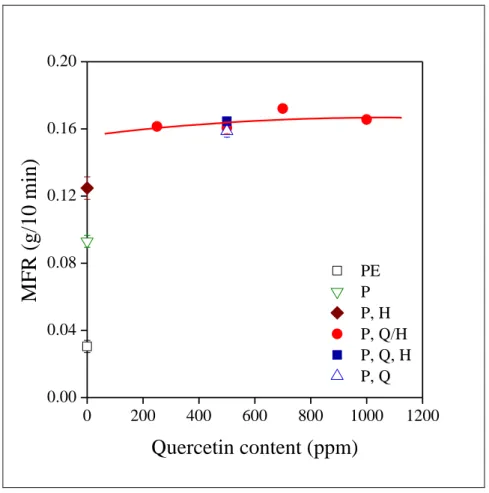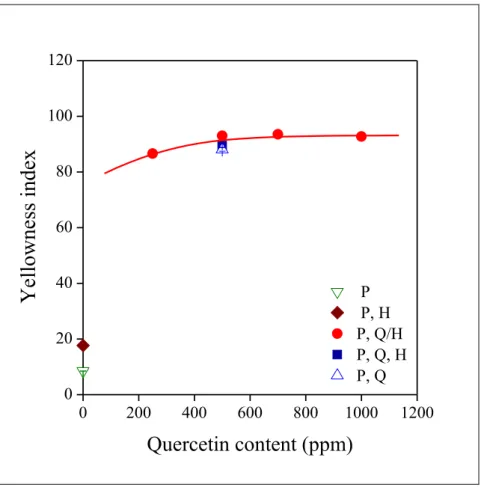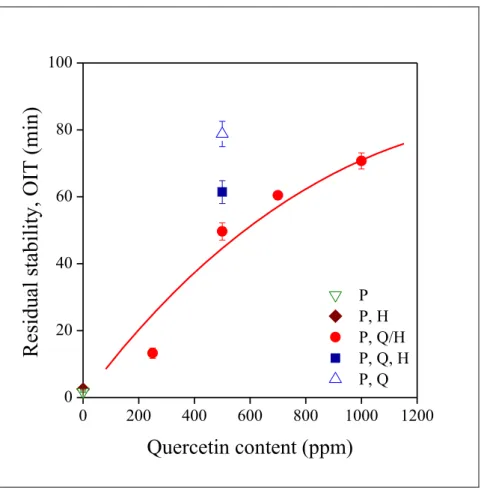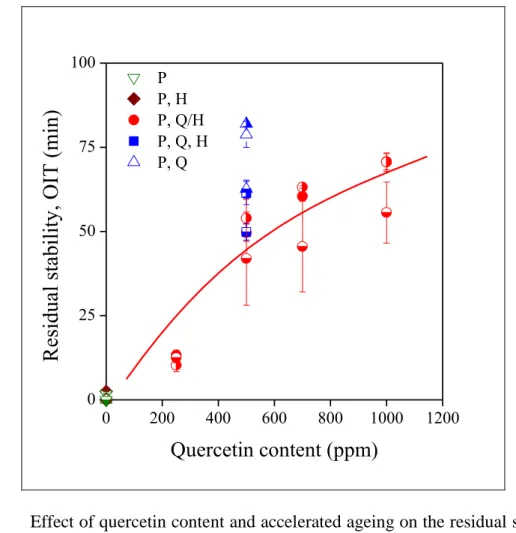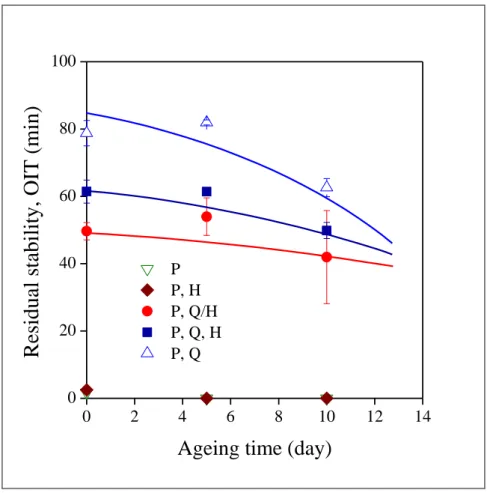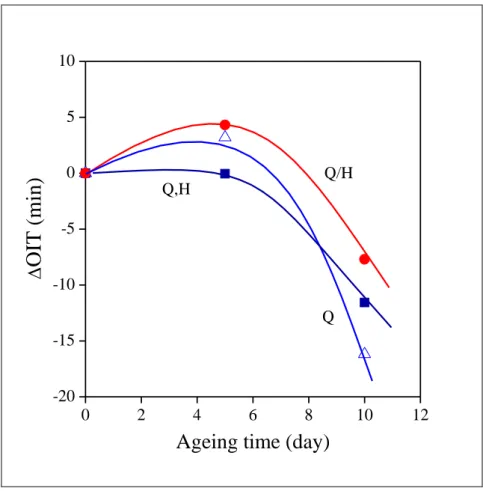LONG TERM STABILIZATION OF PE BY THE CONTROLLED RELEASE OF A NATURAL ANTIOXIDANT FROM HALLOYSITE NANOTUBES
POLYMER DEGRADATION AND STABILITY VOLUME 147, JANUARY 2018, PAGES 229-236 https://doi.org/10.1016/j.polymdegradstab.2017.12.003
https://www.sciencedirect.com/science/article/pii/s0141391017303701
József Hári1,2, Márk Sárközi1,2, Enikő Földes1,2 and Béla Pukánszky1,2
1Laboratory of Plastics and Rubber Technology, Department of Physical Chemistry and Materials Science, Budapest University of Technology and Economics, H-1521 Budapest, P.O. Box 91, Hungary
2Institute of Materials and Environmental Chemistry, Research Centre for Natural Sciences, Hungarian Academy of Sciences, H-1519 Budapest, P.O. Box 286, Hungary
*Corresponding author: Tel: 36-1-463-1078, Fax: 36-1-463-3474, E-mail:
jhari@mail.bme.hu
2 ABSTRACT
A natural antioxidant, quercetin, was adsorbed on the surface of halloysite nanotubes in various amounts to prepare a controlled release device. The combined additive was added to polyethylene providing antioxidant levels of 250, 500, 750 and 1000 ppm. All polymer samples contained 1000 ppm Sandostab PEPQ phosphonite secondary antioxidant as well.
The stabilizing efficiency of quercetin was determined in processing experiments and by accelerated ageing. Quercetin proved to be a very efficient stabilizer of polyethylene. The use of the halloysite nanotube support resulted in more homogeneous dispersion and facilitated the dissolution of the compound in the polymer. Because of the high energy of halloysite surface, the stabilizer adhered to it very strongly and did not dissolve in polyethylene below a critical concentration. The melt stabilization efficiency of quercetin did not decrease in the presence of the halloysite support. The efficiency of long term stabilization decreased somewhat, but halloysite nanotubes pretreated with the stabilizer possessed a controlled release function, ageing was slower in their presence than with separately dispersed components or in the absence of the halloysite.
KEYWORDS: polyethylene, quercetin, halloysite, accelerated ageing, residual stability, controlled release
1. INTRODUCTION
Most polyethylene products are routinely stabilized by the combination of a synthetic phenolic antioxidant and a secondary, processing stabilizer, usually a phosphorous compound. Stabilization in this way is the current state of the art and an accepted technology used at industrial level. Such and similar stabilization packages proved to be very efficient and cost effective thus in the last few decades very little attention was paid to the
3 development of new stabilizers. As a consequence, no alternatives are available to replace traditional hindered phenolic antioxidants in spite the fact that some time ago concerns emerged about the potential health and environmental hazard of these compounds [1], and the questions have not been answered satisfactorily yet. However, because of several reasons, lately the interest increased in the use of natural compounds including antioxidants found in various plants and fruits.
Such natural compounds might present an obvious solution to replace synthetic antioxidants. A large number of natural compounds proved to be beneficial for the human health because of their antioxidant, anti-inflammatory, antiviral or other effects and many of them are being used for therapy for a very long time. Some attempts have been made to use several natural compounds for the stabilization of polymers, and specifically of polyolefins as well. Vitamin E proved to be a very efficient stabilizer [2-5] and it is presently used as antioxidant in ultrahigh molecular weight polyethylene implants [6-8]. Because of its polyaromatic structure lignin also stabilizes polymers in some extent as proved by several studies both in polyethylene and in polypropylene indeed [9-11]. Flavonoids, like quercetin or dihydromyricetin are very efficient antioxidants and some of them are used already in food [12], but attempts are made to apply them in polymers as well [13-16]. The number of potential natural compounds which might be used as antioxidant in polyolefins is very large and only several of them have been studied in stabilization experiments up to now. The antioxidant effect of curcumin [17], quercetin [18] and dihydromyricetin [19] was studied in a Phillips type polyethylene in the presence of a phosphorous secondary stabilizer and the stabilization efficiency of all three exceeded considerably that of the synthetic phenolic antioxidant routinely used in large quantity in industrial practice. The efficiency of another natural antioxidant, silymarin, a flavonolignan compound with the same basic structure as quercetin proved to be much less efficient [20].
4 Most of the natural antioxidants studied as polymer stabilizers up to now have several advantages. Besides being natural, they are also very efficient, quercetin, for example, protected PE from degradation during processing already at 50 ppm additive content and improved long term stability at 250 ppm compared to the 750-1000 ppm synthetic compound used routinely in industrial additive packages. However, natural antioxidants, including quercetin, have some drawbacks as well. The melting temperature of the compound is 316 °C, thus it does not melt under the normal processing conditions of PE, it is very polar resulting in extremely limited solubility in PE, and it gives the polymer a very strong yellow color. The use of a support or a carrier material to disperse quercetin homogeneously in PE might solve at least some of these problems.
Halloysite nanotubes offer an obvious choice for a carrier or support material.
Halloysite is a naturally occurring mineral, which is mined in acceptable purity and used for various purposes including the controlled release of active substances, mainly drugs [21- 33]. Besides the solution of separation problems and water treatment [34-37], halloysite nanotubes were used as carrier material for a stabilizer as well [38, 39]. Fu et al. [39] used halloysite as carrier for N-isopropyl-N'-p-phenylenediamine antioxidant to increase the stability of styrene-butadiene rubber. The approach resulted in improved homogeneity and stability, but at rather large, 2-3 wt%, antioxidant content. With these results in mind, we thoroughly characterized a commercial halloysite product and checked the release of quercetin from it into various solvents [40, 41]. The analysis of the results allowed us to draw conclusions about competitive interactions and their role in the release of the stabilizer into polyethylene. [40]
Subsequently preliminary stabilization experiments were carried out to check the stabilization efficiency of quercetin adsorbed on halloysite and its possible controlled release behavior. A few compounds with a limited number of additive contents were
5 produced in an internal mixer, films were compression molded, subjected to accelerated ageing and the residual stability of the films was estimated by the determination of the oxidation induction time (OIT). The results were promising and indicated that controlled release might be achieved by the use of the nanotubes indeed. However, because of the sample preparation technique used, OIT values were very short, below 6 min, and not very reliable [40]. As a consequence, the decision was made to carry out a more thorough study to determine the efficiency of quercetin adsorbed on halloysite support as stabilizer and the possible controlled release action of the device. The samples were prepared by extrusion this time, quercetin was added in a wider composition range including a number of reference compounds, and besides OIT the samples were characterized more thoroughly with a number of techniques. The most important results are presented in this paper together with considerations about consequences for practice. It must be emphasized here as well that quercetin was compared to a traditional additive package (Irganox 1010) in an earlier project [18]. Quercetin proved to be much more efficient than Irganox 1010 and we did not expect to lose any of this efficiency here either. The goal was to study the dispersion and controlled release effect and not the development of an industrial package. All our studies on natural antioxidants showed that flavonoids usually are much more efficient than traditional phenolic antioxidants currently used in industrial practice [17-20].
2. EXPERIMENTAL 2.1. Materials
The polymer used in the experiments was the Tipelin FS 471 grade ethylene/1- hexene copolymer (melt flow rate: 0.3 g/10 min at 190 °C, 2.16 kg; nominal density: 0.947 g/cm3) polymerized by a Phillips catalyst. The additive free polymer powder was provided by Mol NyRt., Hungary. The halloysite nanotubes (Dragonite XR) were supplied by
6 Applied Minerals, USA. Quercetin (95 %) was purchased from Sigma-Aldrich. The chemical structure of quercetin is presented in Fig. 1. Irrespectively of its form, the antioxidant was added to the polymer in 250, 500, 750 and 1000 ppm, to study the effect of additive content on stability. Reference compounds contained 500 ppm quercetin. 1000 ppm Sandostab PEPQ (PEPQ, Clariant) phosphonite secondary stabilizer was also added to each polyethylene sample.
Fig. 1 The chemical structure of quercetin.
2.2. Sample preparation
Quercetin, was loaded onto the surface of the tubes from ethanol solution. The quercetin content of the pretreated halloysite was 7.4, 15.2, 21.2 and 30.3 wt%. The halloysite content of the suspension was kept at 10 g/dm3 in all treatments. The suspension was treated with ultrasound for 60 min to separate the tubes and then evacuated to remove air from within the tubes. After evacuation the suspension was agitated with ultrasound for another 15 min and then ethanol was removed by evaporation. The samples were kept in a vacuum oven at room temperature overnight. The amount of adsorbed quercetin was determined by thermogravimetry (TGA).
7 The polymer and the additives were homogenized in a high speed mixer. The dry blend was processed and pelletized at 50 rpm speed and 260 °C barrel temperatures using a Rheomex S ¾” type single screw extruder attached to a Haake Rheocord EU 10V driving unit. For further studies, films of about 100 µm thickness were compression molded at 190
°C and 5 min using a Fontijne SRA 100 machine.
Besides the polyethylene compounds containing the halloysite nanotubes pretreated with quercetin (P,Q/H) several reference compounds were also prepared. Polyethylene not containing any additive was also extruded (PE), as well a compound stabilized only with the phosphonite secondary stabilizer (P). The effect of halloysite on stabilization was checked by the preparation of a compound not containing the mineral, but only the two stabilizers (P,Q), while the effect of pretreatment was compared to the simultaneous addition of the components (P,Q,H). The abbreviations in the parentheses will be used in figures to differentiate the compounds and facilitate understanding.
2.3. Characterization
The halloysite was characterized very thoroughly by several methods. The morphology of the mineral was studied by scanning (SEM) and transmission (TEM) electron microscopy. The average size of the particles was determined by a Horiba Partica LA950V2 particle size analyzer. The specific surface area of the tubes, pore size and volume were determined by nitrogen adsorption using a NOVA2000 (Quantachrome, USA) apparatus. The measurements were done at -195 °C after evacuating the sample down to 10-
5 Hgmm at 120 °C for 24 hours. The dispersion component of surface tension was determined by inverse gas chromatography (IGC). The filler was agglomerated with water and the 250-400 m fraction was used for the packing of the column. The dispersion component of surface tension was determined by the injection of n-alkanes at various
8 temperatures between 160 and 300 C because of the high surface energy of the mineral.
The melt flow rate (MFR) of the polymer was determined according to the ASTM D 1238-79 standard at 190 C with 2.16 kg load using a Göttfert MPS-D MFR tester.
Residual thermo-oxidative stability was characterized by the oxidation induction time (OIT) measured at 180 °C in oxygen atmosphere with constant, 20 ml/min flow rate in open aluminum pans using a Perkin Elmer DSC 2 apparatus. The functional groups of polyethylene were determined by FTIR spectroscopy on the 100 m thick compression molded films in transmission mode using a Tensor 27 (Bruker) spectrophotometer. The concentration of vinyl groups was determined from the intensity of the adsorption at 909 cm-1 wavenumber.
The absorption of PE appearing at 2018 cm-1 was used as internal reference [42, 43]. Five parallel measurements were carried out on each sample between 4000 and 400 cm-1 wavelengths at 2 cm-1 resolution by 16 scans. FTIR spectroscopy was used also for the determination of residual PEPQ content. The P(III)-O-C band of phosphites and phosphonites absorbs at 850 cm-1 and after calibration allows the quantitative determination of the residual amount of the secondary antioxidant [44]. The same vibration of PE appearing at 2018 cm-1 was used as internal reference as before. The color of the samples was described by the yellowness index (YI) and the optical L* parameter measured on a Hunterlab Colourquest 45/0 apparatus. Accelerated ageing was done in an air circulation oven (Memmert UFE 600) at 100 °C for 5 and 10 days. The homogeneous distribution of the halloysite nanotubes was checked by optical microscopy on 5 m thick slices cut from the samples with an ultramicrotome. Micrographs were recorded using a Keyence VHX 5000 digital optical microscope.
9 3. RESULTS AND DISCUSSION
The results of the study are reported in several sections. The characteristics of the active halloysite nanotubes containing the stabilizer are discussed first and then the stabilization efficiency of the device is described in the next section. Long term stabilization and controlled release are presented in the last section of the paper together with some discussion on practical consequences.
3.1. Characterization of active nanotubes
The detailed study of the release characteristics of the quercetin/halloysite complex has shown that numerous factors must be considered, which are often partially or completely neglected [40, 41]. Very few attempts are made to determine the surface energy of the nanotubes, their pore size and volume although these determine both the amount of active molecules accommodated inside the tubes as well as the kinetics and amount of released material. The detailed characterization of halloysite nanotubes done earlier [40, 41] showed that their average length is 203 ± 119 nm, external diameter 50 ± 23 nm and internal diameter 15 ± 6 nm accompanied by a pore volume of 0.039 cm3/g. The specific surface area determined by nitrogen adsorption is 57 m2/g. The surface energy of halloysite is very high, the dispersion component of surface tension is 278 mJ/m2, while a value larger than 1000 mJ/m2 was obtained for the polar component. Detailed investigations showed that the energy of the internal and external surfaces is different, the energy is larger inside the tubes leading to preferential adsorption. The critical concentration of adsorption inside the tubes is around 4 wt% quercetin, below this amount all the active molecules are located within the tubes [41]. The large surface energy results in strong adhesion and slow or no release at all below this concentration, especially into an apolar medium like the polyethylene matrix used in these experiments.
10 Based on the results obtained in the previous stage of the research, quercetin was adsorbed on the surface of halloysite in amounts exceeding this critical value (4 wt%) considerably. The active nanotubes were characterized by FTIR spectroscopy. The spectra of selected compositions, some of them from the previous study, are presented in Fig. 2.
The spectra of the halloysite tubes and that of quercetin are also included as reference. The spectra clearly show that at and below 3 wt% quercetin content, the absorption bands of the active molecule do not appear in the spectrum, because of the very strong adhesion of this latter by the internal surface of halloysite. At larger concentrations the characteristic vibrations of quercetin can be detected in the spectrum, in which the main peaks of the mineral and the stabilizer are seen simultaneously.
1800 1700 1600 1500 1400 1300 1200 1100
Wavelength (cm
-1)
15.1 % 7.6 %
C-O
OHC=C
Absor ba nc e
C=OQ
H 1.5 % 3.0 %
Fig. 2 Fourier transform infrared spectra of halloysite (H), quercetin (Q) and halloysite
nanotubes loaded with different amounts of the natural antioxidant. The spectra were recorded on powder samples embedded in KBr pastille.
11 Preferential and very strong adhesion of quercetin within the tubes is demonstrated even better by the correlation between the intensity of the vibration appearing at 1563 cm-1 and the amount of quercetin adsorbed on the surface of the tubes. As the correlation presented in Fig. 3 shows, the intensity of the band belonging to the aromatic skeleton vibration of quercetin is zero below 4 wt% quercetin content and increases only above this amount. The results prove the preferential adsorption of quercetin inside the tubes and predict smaller stabilization efficiency below this level.
0 5 10 15 20 25 30 35
0.0 0.1 0.2 0.3 0.4 0.5 0.6
Intensit y ( ar ea ) a t 1563 cm
-1Quercetin content (wt%)
Fig. 3 Changes in the intensity of the characteristic absorption band of quercetin at 1563 cm-1 wavelength (skeleton vibration of the aromatic rings) plotted as a function of the amount of the quercetin adsorbed on the halloysite nanotubes.
Symbols: () previous measurements, () this work.
12 3.2. Processing stability
One of the expected advantages of using halloysite as support for the stabilizer is better homogeneity and dispersion of quercetin in the PE matrix. The adsorption of the stabilizer on the surface of the mineral prevents its crystallization and the large surface area facilitates dissolution. Two micrographs are compared to each other to check this hypothesis in Fig. 4. Well-developed large crystals appear in Fig 4a recorded on a polymer sample containing 1000 ppm quercetin [18]. The micrograph in Fig. 4b shows the distribution of halloysite particles covered with quercetin. The distribution is homogeneous and quercetin crystals are absent indeed thus justifying the approach at this stage.
Quercetin proved to be a very efficient processing stabilizer in an earlier study [18].
It protected the polymer against degradation already at very small additive contents. In Phillips polyethylene processing stabilization is mainly about the prevention of the formation of long chain branches through the radical reactions of chain-end vinyl groups.
The vinyl group content of our polymer is plotted against quercetin content in Fig. 5.
Unfortunately halloysite also absorbs in the region of the vinyl groups, thus to facilitate comparison halloysite absorption was deducted from the spectra. All samples have the same vinyl content which allow the drawing of several conclusions. The stabilizer package used in the experiments protects the polymer efficiently at all quercetin contents. The secondary stabilizer plays an important role in stabilization, since vinyl content does not decrease during extrusion even when it is used as the only stabilizer. The interaction of quercetin and PEPQ is important in stabilization.
13
a) b)
Fig. 4 Distribution of quercetin without and with halloysite support in polyethylene.
a) 1000 ppm, no halloysite, b) 1000 ppm, halloysite support.
0 200 400 600 800 1000 1200
0.3 0.5 0.7 0.9 1.1
PE P P, H P, Q/H P, Q, H P, Q
Vi nyl/ 1000 C
Quercetin content (ppm)
Fig. 5 Effect of quercetin content on the number of vinyl groups in polyethylene after extrusion. Symbols: () PE, () P; () P, Q; () P, H; () P, Q, H; () P, Q/H; the explanation of the abbreviations are given in the experimental part.
14 The consumption of the secondary antioxidant demonstrates this interaction well.
The amount of residual PEPQ is plotted against quercetin content in Fig. 6. Considerable amount of PEPQ is consumed during extrusion when the primary stabilizer, quercetin is absent, while the levels are much higher when the combination of the two stabilizers is used.
The concentration of the remaining PEPQ is basically the same independently of the amount of quercetin added. The form of addition does not influence significantly PEPQ consumption, maybe the separate introduction of the three components (quercetin, PEPQ, halloysite) leads to somewhat smaller residual secondary antioxidant content. The large consumption might be the result of competitive interactions and adsorption of the two additives on the surface of the mineral, but this tentative explanation needs further study and proof.
0 200 400 600 800 1000 1200
0 40 80 120 160 200
P P, H P, Q/H P, Q, H P, Q
R esi dua l PE P Q ( ppm )
Quercetin content (ppm)
Fig. 6 Dependence of the amount of residual PEPQ on the quercetin content of PE and on the technique of homogenization. Symbols are the same as in Fig. 5
15 Changes in the viscosity of the polymer indicate very sensitively the possible formation of long chain branches, i.e. degradation during processing. The MFR of the samples is plotted against quercetin content in Fig. 7.
0 200 400 600 800 1000 1200
0.00 0.04 0.08 0.12 0.16 0.20
PE P P, H P, Q/H P, Q, H P, Q
M F R (g /10 m in)
Quercetin content (ppm)
Fig. 7 Effect of quercetin content and homogenization technology on the MFR of the polymer. Symbols are the same as in Fig. 5.
A strong increase is observed in the viscosity of the neat polymer not containing any stabilizer. The secondary stabilizer protects the polymer quite efficiently even when it is applied alone, as indicated already by the vinyl group content of the sample. It is interesting to note that MFR is even larger in the presence of the halloysite (P, H). The increase probably does not result from the primary effect of the mineral, since the combination of the phosphorous antioxidant and quercetin without any halloysite leads to the same viscosity
16 as in the presence of the mineral. The observation is interesting, but an unambiguous explanation needs further study. However, the results clearly show that the combination of quercetin and PEPQ efficiently protects the polymer against degradation during processing independently of the form of addition (adsorbed, separately introduced) and halloysite does not influence viscosity at the amount used.
As mentioned in the introductory part, one of the disadvantages of quercetin as stabilizer is its strong yellow color; one hoped for less discoloration when quercetin is adsorbed inside the halloysite tubes. The effect of quercetin content on the color of the polymer is presented in Fig. 8.
0 200 400 600 800 1000 1200
0 20 40 60 80 100 120
P P, H P, Q/H P, Q, H P, Q
Ye llowne ss i nde x
Quercetin content (ppm)
Fig. 8 Correlation between the yellowness index of the PE compounds studied and quercetin content. Symbols are the same as in Fig. 5.
17 According to the results, the discoloration effect is very strong and independent of the homogenization technique; all compounds containing quercetin have a very strong yellow color. We must consider here, however, that quercetin was added always above the critical level of 4 wt%, since below this concentration the stabilizer would not have been active.
Obviously weaker color and efficient stabilization cannot be achieved at the same time, and quercetin can be used only in applications in which color is not an issue.
Residual stability is an important characteristics of PE compounds in long term applications, like pipes or automotive parts. The OIT of the compounds measured at 180 °C in oxygen is plotted as a function of quercetin content in Fig. 9. The correlation is different from those presented in previous figures. Vinyl group content, residual PEPQ, MFR or color practically did not change with increasing quercetin content, while OIT depends considerably on it. In fact, 250 ppm adsorbed quercetin does not render the polymer sufficiently stable, stability reaches acceptable levels only above this additive concentration.
Both the presence of the halloysite and adsorption seem to decrease stabilization efficiency under the conditions of the OIT test. Separate addition of the three components increases residual stability and considerably larger value is obtained when the polymer does not contain the halloysite tubes. Obviously further experiments must be carried out to verify these results, a single composition is not sufficient for drawing unambiguous conclusions, but the results are rather unexpected and not very favorable for long term stabilization.
18
0 200 400 600 800 1000 1200
0 20 40 60 80 100
P P, H P, Q/H P, Q, H P, Q
R esi dua l s tabili ty, OI T ( m in)
Quercetin content (ppm)
Fig. 9 Increasing residual stability (OIT) of PE with increasing quercetin content.
Effect of homogenization technology. Symbols are the same as in Fig. 5.
Besides stabilization, the question of secondary effects, such as mechanical properties or processing behavior, might arise as well deciding if the approach is worth or can be used in practice. At an earlier stage of the research, the effect of the halloysite device on those properties was checked and was found not to be important in our case. The results presented above on MFR show that this property is not influenced practically at all by the presence of the halloysite and no difficulty was encountered during the processing of the samples either. Mechanical properties were characterized by tensile testing and the complete lack of any influence was observed in this case again. Consequently, mechanical properties were not determined in the second stage of the project, because they do not offer any information.
19 3.3. Long term stabilization, controlled release
Long term stability is an important requirement in a number of applications including the automotive industry. The efficiency of stabilizer packages under such conditions can be checked by accelerated ageing. The results of this test are presented in Fig. 10, in which residual stability is plotted against quercetin content. The correlation is very similar to that shown in Fig. 9.
0 200 400 600 800 1000 1200
0 25 50 75
100 P
P, H P, Q/H P, Q, H P, Q
R esi dua l s tabili ty, OI T ( m in)
Quercetin content (ppm)
Fig. 10 Effect of quercetin content and accelerated ageing on the residual stability of PE compounds. Symbols:
( P; P, H; P, Q, H; P, Q/H; P, Q) 0 day, ( P; P, H; P, Q, H; P, Q/H; P, Q) 5 days, ( P; P, H; P, Q, H; P, Q/H;
P, Q) 10 days ageing.
Compounds not containing the primary antioxidant, quercetin, do not have any stability,
20 while OIT increases more or less proportionally with quercetin content. The correlation is not linear, at least not at small quercetin contents, showing the effect of the halloysite carrier on stability, as mentioned above. The absence of the halloysite, or the separate addition of the components leads to increased residual stability, while increased ageing time decreases stability as expected. Information about the time dependence of ageing or controlled release cannot be drawn from the figure in this representation.
Residual stability is plotted against ageing time in Fig. 11 and the representation is much more informative about the time dependence of ageing. Compounds which do not contain quercetin have very limited stability, which further decreases during ageing, however, the differences are not significant. 500 ppm quercetin renders the polymer sufficiently stable and the comparison of the technique of addition indicates considerable differences exceeding 30 min. The presence of halloysite obviously decreases the efficiency of the additive package quite substantially. The most efficient is the quercetin/PEPQ combination without halloysite. The mineral obviously adsorbs the additives on its high energy surface even from the melt. Since adsorption is competitive, both quercetin and PEPQ is attached to the surface, thus more quercetin remains in the polymer and stability decreases somewhat less than in the third case, when quercetin is absorbed prior to the test, in a separate step. Moreover, the adsorption of the polymer cannot be excluded either, although it develops much weaker interactions with halloysite than the two additives. The compounds containing quercetin adsorbed on the halloysite carrier possess the smallest residual stability; adsorption apparently decreases the activity of the stabilizer, hinders its diffusion and/or reactions.
Here one might consider the possible role of impurities present, especially Fe that could readily chelate to quercetin thereby increasing the adsorptive power of the inner-side of the nanotubes. However, several evidences indicate that the role of contaminations, if it
21 exists at all, is small. Vinyl group content and MFR are the same as that of the reference samples, in fact the sample containing halloysite has somewhat larger MFR than that prepared only with PEPQ (see Fig. 7). Residual stability decreased indeed and probably the adsorption of the stabilizer, maybe also chelation, is the main reason. However, more experiments must be carried to prove this tentative explanation. Moreover, the supplier of the halloysite sample claims that its product is very pure, much more than that of the competition and contains only insignificant amount of impurities.
0 2 4 6 8 10 12 14
0 20 40 60 80 100
P P, H P, Q/H P, Q, H P, Q
R esi dua l s tabili ty, OI T ( m in)
Ageing time (day)
Fig. 11 The influence of ageing time and homogenization technology on the residual stability of PE compounds. Symbols are the same as in Fig. 5. Quercetin content was 500 ppm.
The presence of the halloysite carrier seems to be disadvantageous for stabilization.
22 On the other hand, the slope of the correlations indicates slightly decreased ageing rate in compounds containing halloysite. The slope seems to change inversely with stabilizing efficiency; stabilizer consumption, i.e. ageing, is the fastest in the absence of the halloysite nanotubes and the slowest for the pretreated mineral. The effect of addition technology on ageing is demonstrated well by Fig. 12 in which the change of OIT is plotted as a function of ageing time.
0 2 4 6 8 10 12
-20 -15 -10 -5 0 5 10
Q/H
OI T ( m in)
Ageing time (day)
Q,H
Q
Fig. 12 Effect of ageing time on the extent of OIT change compared to the non-aged sample. Symbols are the same as in Fig. 5.
The reference is the OIT of the samples before ageing. A slight increase can be seen in stability at short ageing time, which can be explained by the dissolution of surplus stabilizer at the high temperature of ageing, but OIT decreases sharply at the longer ageing time. The
23 decrease is the largest for the quercetin/PEPQ combination, in the absence of halloysite, while the smallest for the compound containing the pretreated mineral. Apparently, degradation is slower in the presence of halloysite and some controlled release is achieved indeed in agreement with the experience of Fu and Lvov [39].
Although not directly related to stability, it is interesting to follow the change of the color of the samples during ageing (Fig. 13). Color decreases with ageing time, which might be surprising at first, but was explained with the consumption of quercetin having a stronger discoloration effect than its degradation product.
0 2 4 6 8 10 12 14
80 85 90 95 100
P, Q/H P, Q, H P, Q
Ye llowne ss i nde x
Ageing time (day)
Fig. 13 Changes in the color of the PE compounds studied as a function of ageing time;
effect of the homogenization technology. Symbols are the same as in Fig. 5.
The color of the compound containing the quercetin/PEPQ combination without halloysite
24 and that of the one into which the three additives were added separately decreases considerably slower than that of the third compound containing the pretreated controlled device. Apparently the release of well dispersed quercetin from the surface of the carrier results in more reactions, larger decrease in color and larger stability. In spite of the smaller absolute value of stability, decreased rate of ageing is gained through the use of the controlled release device prepared from halloysite nanotubes.
4. CONCLUSIONS
The natural antioxidant, quercetin, used in these experiments is a very efficient stabilizer for polyethylene. In the presence of a phosphonite secondary stabilizer it protects the polymer against degradation during processing already at 50 ppm concentration and renders it stable during use at 250 ppm. Since its solubility in PE is very limited, it forms a separate phase at very small concentration. The use of a halloysite nanotube support results in more homogeneous dispersion and facilitates dissolution to the polymer. Because of the high energy of the halloysite surface, the stabilizer adheres to it very strongly and does not dissolve in polyethylene below a critical concentration. Only stabilizer added above this amount, which is around 4 wt% calculated for the halloysite, stabilizes the polymer resulting in a loss of active additive. Nevertheless, the melt stabilization efficiency of quercetin does not decrease in the presence of the halloysite support. The efficiency of long term stabilization decreases somewhat, but halloysite nanotubes pretreated with the stabilizer possess controlled release function, ageing is slower in their presence than with separately dispersed components or in the absence of the halloysite. It is a question of decision if controlled release and slower ageing are compensated by the loss of efficiency and smaller OIT in long term use.
5. ACKNOWLEDGEMENTS
25 The authors acknowledge the support of the National Scientific Research Fund of Hungary (OTKA Grant No. K 120039) for this project on the modification of polymers. The research work has been part of the "BME R+D+I project" supported by the grant TÁMOP 4.2.1/B-09/1/KMR-2010-0002. Ildikó Erdőné Fazekas is acknowledged for her valuable assistance in sample preparation. The halloysite mineral was kindly supplied by Applied Minerals Inc. (USA).
6. REFERENCES
[1] D. Brocca, E. Arvin, H. Mosbaek, Identification of organic compounds migrating from polyethylene pipelines into drinking water, Water Res. 36(15) (2002) 3675-3680.
[2] S. Al-Malaika, H. Ashley, S. Issenhuth, The antioxidant role of alpha-tocopherol in polymers I. The nature of transformation products of alpha-tocopherol formed during melt processing of LDPE, J. Polym. Sci., Part A: Polym. Chem. 32(16) (1994) 3099-3113.
[3] S. Al-Malaika, C. Goodwin, S. Issenhuth, D. Burdick, The antioxidant role of alpha- tocopherol in polymers II. melt stabilising effect in polypropylene, Polym. Degrad. Stab. 64 (1999) 145-156.
[4] S. Al-Malaika, S. Issenhuth, The antioxidant role of alpha-tocopherol in polymers III.
Nature of transformation products during polyolefins extrusion, Polym. Degrad. Stab. 65(1) (1999) 143-151.
[5] S. Al-Malaika, S. Issenhuth, D. Burdick, The antioxidant role of vitamin E in polymers V. Separation of stereoisomers and characterisation of other oxidation products of dl-alpha- tocopherol formed in polyolefins during melt processing, Polym. Degrad. Stab. 73(3) (2001) 491-503.
[6] R. Lerf, D. Zurbrugg, D. Delfosse, Use of vitamin E to protect cross-linked UHMWPE from oxidation, Biomaterials 31(13) (2010) 3643-3648.
26 [7] J. Shen, L.G. Costa, Y.H. Xu, Y. Cong, Y.J. Cheng, X.C. Liu, J. Fu, Stabilization of highly crosslinked ultra high molecular weight polyethylene with natural polyphenols, Polym. Degrad. Stab. 105 (2014) 197-205.
[8] S. Affatato, J.S. De Mattia, P. Bracco, E. Pavoni, P. Taddei, Wear performance of neat and vitamin E blended highly cross-linked PE under severe conditions: The combined effect of accelerated ageing and third body particles during wear test, J. Mech. Behav. Biomed.
Mater. 64 (2016) 240-252.
[9] P. Alexy, B. Košı́ková, G. Podstránska, The effect of blending lignin with polyethylene and polypropylene on physical properties, Polymer 41(13) (2000) 4901-4908.
[10] C. Pouteau, P. Dole, B. Cathala, L. Averous, N. Boquillon, Antioxidant properties of lignin in polypropylene, Polym. Degrad. Stab. 81(1) (2003) 9-18.
[11] A. Gregorová, B. Košíková, R. Moravčík, Stabilization effect of lignin in natural rubber, Polym. Degrad. Stab. 91(2) (2006) 229-233.
[12] F. Shahidi, P. Ambigaipalan, Phenolics and polyphenolics in foods, beverages and spices: Antioxidant activity and health effects – A review, J. Funct. Foods 18, Part B (2015) 820-897.
[13] J.L. Koontz, J.E. Marcy, S.F. O'Keefe, S.E. Duncan, T.E. Long, R.D. Moffitt, Polymer Processing and Characterization of LLDPE Films Loaded with alpha-Tocopherol, Quercetin, and Their Cyclodextrin Inclusion Complexes, J. Appl. Polym. Sci. 117(4) (2010) 2299-2309.
[14] M.D. Samper, E. Fages, O. Fenollar, T. Boronat, R. Balart, The potential of flavonoids as natural antioxidants and UV light stabilizers for polypropylene, J. Appl. Polym. Sci.
129(4) (2013) 1707-1716.
27 [15] M.L. Xin, Y.J. Ma, K. Xu, M.C. Chen, Dihydromyricetin An effective non-hindered phenol antioxidant for linear low-density polyethylene stabilisation, J. Therm. Anal.
Calorim. 114(3) (2013) 1167-1175.
[16] M.L. Xin, Y.J. Ma, W.H. Lin, K. Xu, M.C. Chen, Use of dihydromyricetin as antioxidant for polypropylene stabilization, J. Therm. Anal. Calorim. 120(3) (2015) 1741- 1747.
[17] D. Tátraaljai, B. Kirschweng, J. Kovács, E. Földes, B. Pukánszky, Processing stabilisation of PE with a natural antioxidant, curcumin, Eur. Polym. J. 49(6) (2013) 1196- 1203.
[18] D. Tátraaljai, E. Földes, B. Pukánszky, Efficient melt stabilization of polyethylene with quercetin, a flavonoid type natural antioxidant, Polym. Degrad. Stab. 102 (2014) 41-48.
[19] B. Kirschweng, K. Bencze, M. Sárközi, B. Hégely, G. Samu, J. Hári, D. Tátraaljai, E.
Földes, M. Kállay, B. Pukánszky, Melt stabilization of polyethylene with dihydromyricetin, a natural antioxidant, Polym. Degrad. Stab. 133 (2016) 192-200.
[20] B. Kirschweng, B. Vörös, D. Tátraaljai, M. Zsuga, E. Földes, B. Pukánszky, Natural antioxidants as melt stabilizers for PE: Comparison of silymarin and quercetin, Eur. Polym.
J. 90 (2017) 456-466.
[21] E. Joussein, S. Petit, J. Churchman, B. Theng, D. Righi, B. Delvaux, Halloysite clay minerals - A review, Clay Miner. 40(4) (2005) 383-426.
[22] Y.M. Lvov, D.G. Shchukin, H. Mohwald, R.R. Price, Halloysite clay nanotubes for controlled release of protective agents, Acs Nano 2(5) (2008) 814-820.
[23] E. Ruiz-Hitzky, K. Ariga, Y. Lvov, Bio-inorganic Hybrid Nanomaterials: Strategies, Syntheses, Characterization and Applications, WILEY-VCH Verlag GmbH & Co. KGaA,, Weinheim, 2008.
28 [24] N.G. Veerabadran, R.R. Price, Y.M. Lvov, Clay nanotubes for encapsulation and sustained release of drugs, Nano 2(2) (2007) 115-120.
[25] R.S. Byrne, P.B. Deasy, Use of porous aluminosilicate pellets for drug delivery, J.
Microencapsulation 22(4) (2005) 423-437.
[26] R.R. Price, B.P. Gaber, Y. Lvov, In-vitro release characteristics of tetracycline HCl, khellin and nicotinamide adenine dineculeotide from halloysite; a cylindrical mineral, J.
Microencapsulation 18(6) (2001) 713-722.
[27] M. Krejčová, M. Rabišková, Nano- and microtubes for drugs, Chem. Listy 109(9) (2008) 35-39.
[28] D. Fix, D.V. Andreeva, Y.M. Lvov, D.G. Shchukin, H. Moehwald, Application of Inhibitor-Loaded Halloysite Nanotubes in Active Anti-Corrosive Coatings, Adv. Funct.
Mater. 19(11) (2009) 1720-1727.
[29] A.W. Smith, Biofilms and antibiotic therapy: Is there a role for combating bacterial resistance by the use of novel drug delivery systems?, Adv. Drug Delivery Rev. 57(10) (2005) 1539-1550.
[30] S.R. Levis, P.B. Deasy, Use of coated microtubular halloysite for the sustained release of diltiazem hydrochloride and propranolol hydrochloride, Int. J. Pharm. 253(1-2) (2003) 145-157.
[31] H.M. Kelly, P.B. Deasy, E. Ziaka, N. Claffey, Formulation and preliminary in vivo dog studies of a novel drug delivery system for the treatment of periodontitis, Int. J. Pharm.
274(1-2) (2004) 167-183.
[32] H. Cornejo-Garrido, A. Nieto-Camacho, V. Gómez-Vidales, M.T. Ramírez-Apan, P.
del Angel, J.A. Montoya, M. Domínguez-López, D. Kibanova, J. Cervini-Silva, The anti- inflammatory properties of halloysite, Appl. Clay Sci. 57 (2012) 10-16.
29 [33] A. Ghebaur, S.A. Garea, H. Iovu, New polymer-halloysite hybrid materials-potential controlled drug release system, Int. J. Pharm. 436(1-2) (2012) 568-573.
[34] P. Liu, M.F. Zhao, Silver nanoparticle supported on halloysite nanotubes catalyzed reduction of 4-nitrophenol (4-NP), Appl. Surf. Sci. 255(7) (2009) 3989-3993.
[35] Y.F. Xie, D.Y. Qian, D.L. Wu, X.F. Ma, Magnetic halloysite nanotubes/iron oxide composites for the adsorption of dyes, Chem. Eng. J. 168(2) (2011) 959-963.
[36] P. Luo, Y.F. Zhao, B. Zhang, J.D. Liu, Y. Yang, J.F. Liu, Study on the adsorption of Neutral Red from aqueous solution onto halloysite nanotubes, Water Res. 44(5) (2010) 1489-1497.
[37] J. Wang, X. Zhang, B. Zhang, Y. Zhao, R. Zhai, J. Liu, R. Chen, Rapid adsorption of Cr (VI) on modified halloysite nanotubes, Desalination 259(1-3) (2010) 22-28.
[38] D.G. Shchukin, H. Mohwald, Surface-engineered nanocontainers for entrapment of corrosion inhibitors, Adv. Funct. Mater. 17(9) (2007) 1451-1458.
[39] Y. Fu, D.T. Zhao, P.J. Yao, W.C. Wang, L.Q. Zhang, Y. Lvov, Highly Aging-Resistant Elastomers Doped with Antioxidant-Loaded Clay Nanotubes, ACS Appl. Mater. Interfaces 7(15) (2015) 8156-8165.
[40] J. Hári, Á. Gyürki, M. Sárközi, E. Földes, B. Pukánszky, Competitive interactions and controlled release of a natural antioxidant from halloysite nanotubes, J. Colloid Interface Sci. 462 (2016) 123-129.
[41] J. Hári, P. Polyák, D. Mester, M. Mičušík, M. Omastová, M. Kállay, B. Pukánszky, Adsorption of an active molecule on the surface of halloysite for controlled release application: Interaction, orientation, consequences, Appl. Clay Sci. 132 (2016) 167-174.
[42] E. Földes, M. Iring, F. Tüdős, Degradation of HDPE and LLDPE in closed mixing chamber: a comparison, Polym. Bull. 18 (1987) 525-532.
30 [43] E. Földes, Z. Szabó, Á. Janecska, G. Nagy, B. Pukánszky, Quantitative analysis of functional groups in HDPE powder by DRIFT spectroscopy, Macromolecular Symposia 202(1) (2003) 97-116.
[44] E. Földes, E. Maloschik, I. Kriston, P. Staniek, B. Pukánszky, Efficiency and mechanism of phosphorous antioxidants in Phillips type polyethylene, Polym. Degrad. Stab.
91(3) (2006) 479-487.
